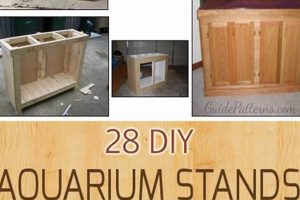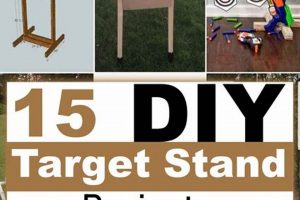A do-it-yourself project designed to hold recipe books open and upright for convenient reading while cooking represents a functional craft endeavor. Such projects commonly utilize readily available materials and simple construction techniques, providing a personalized alternative to commercially manufactured kitchen accessories. For instance, repurposed wooden boards or upcycled metal frames can be transformed into customized supports for cookbooks, tablets, or other instructional materials.
The inherent utility of a hands-on construction approach offers several advantages, including cost savings, creative expression, and environmental consciousness through material reuse. Historically, devices for holding books open have been prevalent, evolving from simple props to more sophisticated mechanisms. This contemporary iteration addresses the specific need for hands-free access to recipes within the challenging environment of a kitchen, promoting efficiency and hygiene.
The following sections will explore various design concepts, material choices, construction methodologies, and finishing techniques suitable for creating a customized reading support. These guidelines aim to provide a comprehensive resource for individuals seeking to construct a practical and aesthetically pleasing kitchen accessory using their own skills and resources.
Tips for Constructing a Recipe Book Support
These suggestions aim to facilitate the successful creation of a functional and durable structure for holding cookbooks and similar instructional materials. Careful attention to material selection and construction methods is essential for optimal results.
Tip 1: Prioritize Stable Base Design: A wide and stable base is crucial to prevent tipping, particularly when supporting larger, heavier books. Consider a triangular or rectangular base constructed from sturdy materials like hardwood or thick plywood.
Tip 2: Implement Adjustable Support Angle: An adjustable support angle allows for optimal viewing, regardless of user height or kitchen layout. Incorporate a hinged mechanism or a series of grooves to enable angle modification.
Tip 3: Select Moisture-Resistant Materials: Given the kitchen environment, prioritize materials that resist moisture damage. Treated wood, stainless steel, or durable plastics are suitable choices. Apply a waterproof sealant to vulnerable surfaces.
Tip 4: Ensure Adequate Book Retention: Implement features to securely hold pages open, such as a retaining lip along the bottom edge or strategically placed clips. This prevents pages from turning unintentionally.
Tip 5: Consider Space-Saving Design: In kitchens where space is limited, explore foldable or collapsible designs that can be easily stored when not in use. Hinged supports and removable back panels are potential solutions.
Tip 6: Focus on Easy Cleaning: Choose materials and finishes that are easy to wipe clean, resisting grease and food stains. Smooth, non-porous surfaces are preferable.
Tip 7: Incorporate Safety Features: Sand down any sharp edges or corners to prevent accidental cuts or scrapes. Ensure that all fasteners are securely tightened to avoid structural instability.
Adhering to these guidelines will contribute to the creation of a durable, functional, and aesthetically pleasing accessory that enhances the cooking experience.
The following section will address common challenges encountered during construction and provide troubleshooting strategies.
1. Stability
Stability is paramount in the design and construction of a do-it-yourself recipe book support. Without adequate stability, the structure is prone to tipping, rendering it ineffective and potentially hazardous in a kitchen environment. The following facets delineate key elements contributing to the overall steadiness of the construction.
- Base Geometry and Footprint
The shape and size of the base directly correlate with the support’s resistance to tipping forces. A wider base, whether rectangular, triangular, or circular, provides a greater distribution of weight and a lower center of gravity. This increased footprint enhances stability, particularly when supporting larger or heavier cookbooks. Conversely, a narrow or unstable base increases the risk of the entire structure overturning.
- Material Mass and Distribution
The selection of materials with sufficient mass contributes significantly to stability. Heavier materials, such as hardwood or thick gauge steel, provide a lower center of gravity. Distributing this mass strategically, with the heaviest components concentrated at the base, further enhances the support’s resistance to external forces. Conversely, lightweight materials may compromise stability, especially when paired with uneven weight distribution.
- Center of Gravity Management
The position of the center of gravity relative to the base of support is a critical determinant of stability. A lower center of gravity increases stability. Design considerations should aim to keep the center of gravity as low as possible, even when supporting a book. This can be achieved through strategic material placement and base design. A high center of gravity, in contrast, makes the structure more susceptible to tipping.
- Surface Friction and Contact
The frictional properties of the base material and its contact with the underlying surface influence stability. Materials with high coefficients of friction, such as rubber or non-slip pads, provide increased resistance to sliding. Ensuring full and even contact between the base and the countertop is essential to prevent rocking or instability. Smooth or uneven surfaces, conversely, can reduce stability and increase the risk of the device toppling.
These elements collectively determine the overall stability of a hands-on recipe book support. Proper attention to each facet is essential for creating a functional and safe device, enabling cooks to consult recipes without the risk of the support toppling over during use. In the design phase, carefully consider these points to improve the user experience, ensuring both safety and convenience.
2. Ergonomics
Ergonomics plays a pivotal role in the design and functionality of a do-it-yourself recipe book support. The integration of ergonomic principles ensures the device promotes comfort, efficiency, and safety for the user, reducing strain and optimizing the cooking experience.
- Viewing Angle Optimization
The angle at which the recipe is presented directly impacts neck and eye strain. An ergonomically sound design allows for adjustable viewing angles, accommodating users of varying heights and visual needs. A shallow angle might require excessive head tilting, while an overly steep angle can distort the recipe’s appearance. The goal is a natural, comfortable viewing position that minimizes physical discomfort during prolonged use.
- Reach and Accessibility
The distance between the user and the recipe book should be within a comfortable reach zone. An excessively distant recipe necessitates leaning forward, leading to back strain. Conversely, a recipe positioned too closely may induce eye strain. A design that allows for variable placement or adjustment in proximity ensures the recipe is readily accessible without compromising the user’s posture or visual comfort.
- Page Turning Facilitation
The ease with which pages can be turned influences the overall user experience. An ergonomic support incorporates features that simplify page turning, such as retaining clips that are easily disengaged or a design that allows for one-handed operation. Cumbersome page-turning mechanisms can disrupt the cooking process and contribute to frustration. Simple, intuitive designs enhance efficiency and minimize interruptions.
- Stability and Vibration Dampening
An unstable support can cause distracting vibrations or movements, leading to visual fatigue and potential inaccuracies in recipe interpretation. An ergonomic design prioritizes stability, minimizing unwanted movement and ensuring a steady viewing surface. This may involve incorporating dampening materials or designing a robust base that resists vibrations from nearby appliances or kitchen activities.
Incorporating these ergonomic considerations into the creation of a hands-on recipe book support results in a more comfortable, efficient, and user-friendly kitchen accessory. It enhances the overall cooking experience by reducing physical strain and facilitating seamless recipe consultation.
3. Material Durability
Material durability is a critical factor in the longevity and utility of any do-it-yourself recipe book support. The kitchen environment presents numerous challenges, including exposure to moisture, heat, grease, and potential impacts. Consequently, the selection of robust and resilient materials is paramount to ensure the support withstands these conditions and maintains its structural integrity over time. Failure to consider material durability can result in premature degradation, warping, or even complete structural failure, rendering the support unusable. For instance, using untreated softwood in a humid kitchen environment will likely lead to rapid moisture absorption, swelling, and eventual decay. Conversely, employing materials such as treated hardwood, stainless steel, or durable plastics will enhance the support’s resistance to environmental stressors and extend its lifespan.
The specific demands of a kitchen environment necessitate careful consideration of several material properties. Water resistance is crucial to prevent moisture damage and warping. Heat resistance is important, especially if the support is placed near a stove or oven. Resistance to cleaning agents and food stains is also essential for maintaining a hygienic surface. Furthermore, impact resistance can protect the support from accidental knocks or drops, preserving its structural integrity. Real-world examples highlight the practical significance of material durability. A support constructed from high-density polyethylene (HDPE), a durable and water-resistant plastic, will fare significantly better than one made from untreated cardboard. Similarly, a support finished with a waterproof sealant will be more resistant to spills and stains than one left untreated.
In conclusion, material durability is an indispensable consideration in the creation of a lasting and functional support. Selecting appropriate materials with resistance to moisture, heat, grease, and impact is crucial for withstanding the rigors of the kitchen environment. Prioritizing material durability enhances the overall value and longevity of the hands-on project, providing a reliable and convenient aid for years to come. The investment in durable materials translates into a more sustainable and cost-effective solution, minimizing the need for frequent repairs or replacements.
4. Page Retention
Effective page retention mechanisms are intrinsically linked to the utility and practicality of any do-it-yourself recipe book support. The primary function of such a support is to hold a cookbook or other instructional material open at a specific page, thereby freeing the user’s hands for cooking tasks. Without adequate page retention, the book is prone to closing spontaneously, disrupting the cooking process and potentially leading to errors or inefficiencies. Consequently, the design and implementation of a reliable page retention system is a critical component of a successful support. The absence of such a system negates the core benefit of the support, rendering it little more than a decorative object. Examples of inadequate page retention manifest in a variety of ways, from pages slowly drifting closed due to gravity to sudden closures caused by drafts or accidental bumps. These occurrences necessitate constant readjustment, distracting the cook and undermining the intended convenience of the support.
Various design approaches can address the need for secure page retention. Simple solutions include the use of weighted clips or elastic bands to hold pages in place. More elaborate designs might incorporate hinged arms with adjustable pressure or strategically placed pegs that fit into the spine of the book. The choice of method depends on factors such as the size and weight of the books to be supported, the desired level of adjustability, and the overall aesthetic of the support. Regardless of the specific approach, the goal is to provide a reliable and unobtrusive means of keeping the pages open, allowing the cook to focus on the recipe without interruption. Practical applications of effective page retention are evident in any cooking scenario where hands-free access to a recipe is essential. For instance, when preparing a complex dish requiring precise measurements and timing, the ability to consult the recipe without needing to physically hold the book open is invaluable.
In summary, page retention is an indispensable element in the design and functionality of any hands-on recipe book support. A well-designed retention mechanism ensures that the book remains open and accessible, enhancing the user’s cooking experience by reducing distractions and promoting efficiency. The challenges associated with page retention are addressed through a variety of design solutions, each aimed at providing a reliable and unobtrusive means of keeping the pages open. The practical significance of this understanding lies in the creation of a more functional and user-friendly kitchen accessory.
5. Space Efficiency
Space efficiency represents a crucial design consideration for any do-it-yourself recipe book support, particularly in modern kitchens where counter space is often limited. The dimensions and form factor of the support directly impact its practicality and usability. A bulky or cumbersome support consumes valuable workspace, hindering food preparation and overall kitchen workflow. In contrast, a space-efficient design minimizes its footprint, allowing for optimal use of available counter space. This principle is especially relevant in smaller kitchens or apartments where maximizing functionality within a confined area is paramount. The cause-and-effect relationship is clear: a space-inefficient support detracts from the cooking experience, while a space-efficient design enhances it.
The importance of space efficiency manifests in various design choices. Folding or collapsible designs are particularly effective in conserving space when the support is not in use. Such designs can be easily stored in a drawer or cabinet, freeing up valuable counter space. Similarly, minimalist designs that prioritize function over form can minimize the overall size of the support without compromising its stability or usability. Real-life examples demonstrate the practical significance of this understanding. A compact support designed to fit neatly against a backsplash or wall occupies minimal counter space, allowing for efficient food preparation. Conversely, a large, ornate support can dominate a small kitchen, making it difficult to maneuver and prepare meals effectively.
In conclusion, space efficiency is an indispensable component of a successful hands-on recipe book support. The design should prioritize a compact form factor and consider storage options to minimize its impact on kitchen workspace. Addressing space efficiency enhances the overall utility and practicality of the support, making it a valuable and convenient addition to any kitchen. Failing to consider this aspect can result in a cumbersome and disruptive accessory, ultimately diminishing its value.
Frequently Asked Questions
The following elucidates common inquiries regarding the construction and functionality of supports for recipe books.
Question 1: What is the recommended angle for a recipe book on a support?
The optimal viewing angle is typically between 15 and 30 degrees from the horizontal plane. This range minimizes neck strain and promotes comfortable reading.
Question 2: Which materials offer the best combination of durability and affordability?
Plywood, particularly when treated with a water-resistant sealant, presents a viable balance between cost and longevity. Alternatives include reclaimed wood and certain durable plastics.
Question 3: How can slippage on smooth countertop surfaces be prevented?
Adhesive rubber feet or non-slip pads affixed to the base of the support significantly enhance grip and minimize the risk of movement during use.
Question 4: Is it necessary to apply a finish to the completed support?
The application of a finish, such as varnish or sealant, is advisable to protect the underlying material from moisture, grease, and stains common in kitchen environments.
Question 5: What are the key considerations for ensuring stability with large or heavy cookbooks?
A wide base, a low center of gravity, and the use of dense materials are essential for providing adequate support and preventing tipping.
Question 6: How can page-turning be facilitated while using a recipe book support?
Spring-loaded clips, strategically placed page holders, or a design that allows for easy one-handed page manipulation can simplify this process.
In summary, careful consideration of viewing angle, material selection, surface grip, finishing, stability, and page-turning mechanisms are crucial for creating a functional and durable recipe book support.
The subsequent section will explore advanced design concepts for these specialized kitchen accessories.
Conclusion
The preceding exploration of the hands-on construction of supports for recipe books has illuminated critical design considerations, material choices, and functional requirements. Through careful attention to stability, ergonomics, material durability, page retention, and space efficiency, individuals can fabricate a practical and aesthetically pleasing kitchen accessory tailored to their specific needs and resources. The versatility of this domain facilitates customization and personalization beyond commercially manufactured alternatives.
The creation of a functional support represents a tangible expression of resourcefulness and problem-solving. Further innovation in this area may focus on integrating digital technology, such as tablet integration or voice-activated controls. The enduring value of a well-crafted and customized kitchen implement underscores the continued relevance of hands-on ingenuity in the modern home.



![Build a Better DIY Table Saw Stand [Plans & Guide] The DIY Hub: Creative Crafts, Repairs & Life Hacks Build a Better DIY Table Saw Stand [Plans & Guide] | The DIY Hub: Creative Crafts, Repairs & Life Hacks](https://craftingdiycenter.com/wp-content/uploads/2025/07/th-3315-300x200.jpg)



